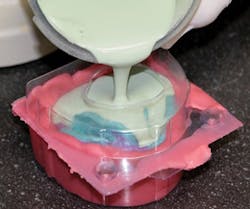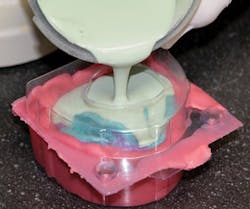Virtual model becoming standard method
By Joseph J. Massad, DDS
Welcome back! This month, I would like to discuss a recent advancement in fabricating stone models, either in-office or for your lab. The digital age of dentistry is here, and as we approach better and refined scanning technologies, it appears that the virtual model will eventually be the standard method and the stone model will disappear into the night. However, most implant cases involving digitally designed milled bars and fixed prosthetics are on the rise. In the meantime, advances in conventional pourable materials and methods have been simplified, and have made the conventional process very accurate and convenient. In the past, we've had our dental assistants pour up models in the lab, thinking that would be quicker and less expensive than sending them to a lab. However, that's not always the case.
When we look at the procedure performed in most offices, we see excessive waste of material, extremely dirty work surface areas, and plaster dust foot markings on the floor, and it requires significant cleanup. Just the time it takes to clean makes the entire process not financially feasible. I know in talking with dental offices across the country that large practices generally will either have a lab in-house, or have someone picking up dozens of impressions to be poured at labs. Spending the time and cost to package up impressions and mail round trip also adds cost to the bottom line, and delays the overall completion of prosthetic cases.
Casting dental models has been significantly improved by the use of fluid ISO type 4 die stones, which need no vibrating, when compared to medium-viscosity die stones, where vibrating is required. Also, liquid pours may decrease movement of the implant analog during the pour-up process. With medium-viscosity, flow-assisted die stones, casting the model may place pressure against the analogs, creating micromovement and resulting in bar type attachments rejection at delivery. In order for me to describe the method I've been using step by step, please see all photos online at http://www.dentistryiq.com/index.html.
First, cut the handle off your impression dental tray to allow room to place the tray into a dental plastic closed environment container. The container will help you in boxing the impression and holding the liquid die stone during polymerization. These containers can be purchased through your dental laboratory. There are generally three sizes available, which should be sufficient to accommodate most size dental arches. Now, with the handle cut off the tray, fill the bottom half of the container with alginate or other appropriate boxing material, and then place the impression into the alginate until it flows up to the desired area to be boxed.
Boxing procedures give much cleaner final definitive products, and the container will hold the fluid die stone during polymerization without any overflow. Now, close the container after cutting a hole in the top lid portion to allow an area to pour the stone into. Then carefully measure your water/powder ratio and mechanically spatulate while extracting air in a variable mixer. (Whip Mix Corp) Once the stone has been completely spatulated, it will be in a liquid state, and it is very simple to now pour directly through the hole in the plastic container until the appropriate amount is dispensed. The approximate working time is four to six minutes, and the set time is approximately eight minutes. Once the stone completely cures, remove the model to reveal a nice cast with minimum trimming. To view all images, please click here.
Joseph Massad
Search for "Dr. Joe Massad" on www.dentistryiq.com for more information.
Dr. Joe Massad may be reached by phone at (918) 749-5600 or by e-mail at [email protected].
To see Dr. Massad's video tips, visit www.DentalLibrary.com
Past DE Articles

